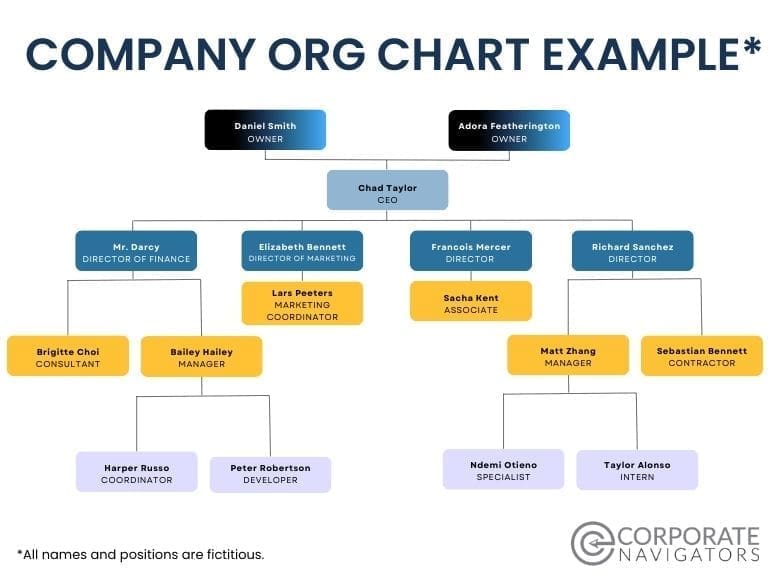
Table of Contents
Finding an Accurate Organizational Chart of a Competitor’s Company
Whether you want to know how a company structures its teams or identify qualified candidates in similar industries, looking at the organizational charts of competitors might be a good place to start.
However, making an accurate organization chart can be challenging when you do not have direct access to this type of information. This is why you should outsource this investigation to a professional recruitment research firm that uncovers company structures with advanced techniques.
Org charts, also called organizational charts, provide fundamental information about whom people report to and manage in a company. This visual representation of where people stand will give you valuable insights on who may have the qualities you need in a future hire.
At Corporate Navigators, we offer Org Chart generation as part of our core services, which can be paid hourly or be included in a contract package.
What is an Org Chart?
An organizational chart is essentially a blueprint of a company’s structure, illustrating its chain of command, team members, and reporting relationships. Whether you’re a new employee trying to understand your organization’s structure or an HR professional looking for a suitable external candidate for an open position, accessing an accurate org chart is crucial.
While it first seems easy to create an outside company’s organization chart, typical avenues like LinkedIn profiles and even a company’s “about us” page may not be up to date about a company’s internal structure. If you need accurate org charts, seeking professional help from Recruiting Researchers will give you an advantage over other methods.
Where Do I Find an Accurate Org Chart?
1. A Recruiting Research Firm Like Corporate Navigators
- Most Accurate and up-to-date information that’s usually not publicly available. Well worth the investment for the quality.
While it may seem more complicated at first to set up a call and explain your needs to a researcher, the time you save in receiving accurate, up-to-date information makes up for the times you’d potentially go back to the drawing board after hitting dead ends with outdated information of reporting structures from public sources.
At Corporate Navigators, we dive deep into a company’s organizational structure. Using advanced research techniques that go beyond AI or publicly available information databases, we promise that all information about a company’s structure is accurate upon the day of delivery.
2. The Company’s Website
- When available, this can provide a decent picture of the company’s structure, but may be incomplete or out of date.
Need a quick idea of who’s in charge from the top-down or is in the position you need to fill? On company websites, there may be an “HR” or “About Us” section that can shed light on the key players and job titles.
You may also get lucky and find complete organizational charts in sections called “About Us,” “Our Team,” or “Corporate Governance.” However, use this information with caution, as these charts may be simplified or out of date. Nevertheless, you can get a decent overview of who is in charge in different departments in this method.
3. LinkedIn + Other Social Media Platforms
- Fairly accessible, but with a high probability of being out of date.
Another decent source of information can be available to the public on LinkedIn. You may find organizational charts on profiles of larger companies, or you can try to piece together who is in charge when you search for “people” under a certain company’s name. Also, try navigating to the company’s LinkedIn page and look for the “See all X employees on LinkedIn” link to view the employees who have accounts.
- Note: Since 67% of LinkedIn profiles are out of date or inaccurate, you should take this information with a grain of salt.
4. Public Business Directories
- Depending on how often directories are updated and when you check them, their relevance and accuracy may vary.
By checking industry-specific directories and websites like Bloomberg, Hoovers, and other sources, you may find detailed company profiles that can include organizational charts. The closer you are to the information’s publication date, the higher the chance of accuracy.
5. Annual Reports and Filings from the SEC
- Definitely not a bad start if you need to get a general idea of a company’s status, but usually not a complete or up-to-date picture.
The Securities and Exchange Commission (SEC) requires all companies in the United States to file organizational charts in their SEC filings. These can be found in documents like Form 10-K or proxy statements. The older the information, the less reliable it is, but this isn’t a bad source to supplement your query.
6. Your Professional Network
- Sometimes the old fashioned method of speaking with people you know can shed light on a company’s organizational structure.
Never underestimate the power of tapping into your professional network connections. Perhaps you know a stakeholder who has some useful information on a startup you’re interested in. People you have worked with, or friends in a different company might have insider knowledge or connections regarding the company you’re researching. You never know what connection may prove useful!
7. Organizational Chart Tools
- You may get lucky in finding publicly accessible information for major companies on these integrations. Not a reliable tool for smaller companies. Also, this information may not be up-to-date.
If you use online tools or org chart software that are designed specifically for creating and sharing organizational charts, you may come across some free information. For instance, a program like LucidChart may have some org chart templates from major companies since they were publicly accessible. It’s not a bad idea to check these programs and apps for low-hanging fruit to give you a head start.
Tips for Achieving Accuracy in an Org Chart
Use a professional Recruitment Research Team. If you go this route, then you don’t need to worry about the following three steps. The researcher will do everything for you and then present you with an accurate type of organizational chart for your needs.
Verify Sources: Cross-reference information from multiple sources to ensure accuracy, especially for leadership positions.
Check The Publication Date: If you come across a publicly available chart, check when it was last updated or posted. Organizational structures can change frequently, especially in dynamic industries.
Check Official Sources: When verifying data, look for information from official company channels or reputable business publications.
Get Accurate, Up-to-Date Org Charts of other Companies
Finding an accurate external organizational chart involves utilizing a combination of online resources, networking, and verifying information. When searching for top talent for a leadership position or important decision-making in company, knowing where to find qualified candidates from other companies is paramount.
Whether you’re conducting market research, preparing for a job interview, or analyzing corporate strategy, having an up-to-date org chart can provide valuable insights into another company’s operations and hierarchy.





